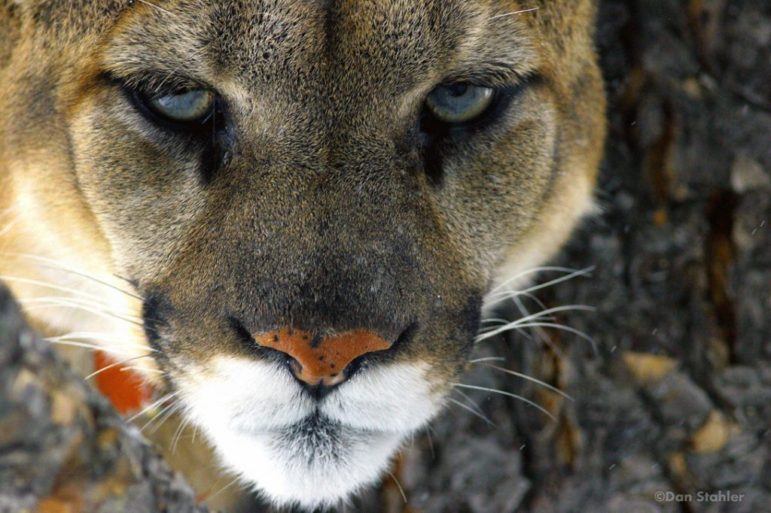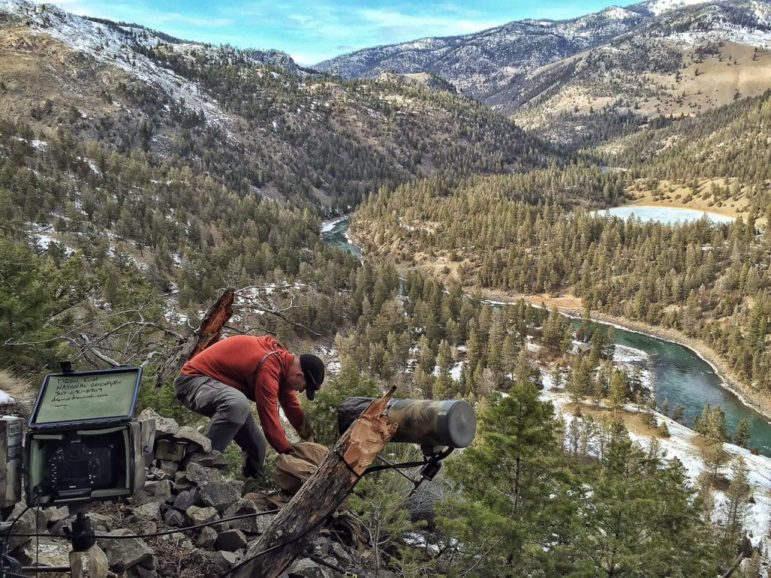
The Yellowstone Cougar Project uses a combination of tracking collars, genetic analysis, camera traps and field work to uncover the ecology of how cougars are connected to Yellowstone National Park’s landscape. (Photo by Dan Stahler)
The young male wasn’t an Olympic athlete in training, but his daily movements were tracked and recorded with amazing precision. He wasn’t on a crash diet, but what he ate was well-known, along with where and when he ate it. He wasn’t a patient with a rare or fatal disease, but his entire genome was sequenced. And he wasn’t a crime victim, although his violent death at a young age was determined by lab work and an arduous field investigation.
The young male was M198, one of the first cougars fitted with a special tracking collar that is a cornerstone of the Yellowstone Cougar Project. Begun in 2014, the planned five-year study is using a range of high-tech, non-invasive methods to better understand how many cougars live in the park—particularly in the northern range. The project also studies how the big cats fit into the larger ecosystem of major predators in Yellowstone National Park that includes grizzly bears and gray wolves.
Yellowstone wildlife biologist Dan Stahler leads the Cougar Project, which uses a combination of tracking collars, genetic analysis, camera traps and field work to “reveal the fascinating ecology of how cougars are connected to this wild landscape.”
Also known as pumas, mountain lions and panthers, cougars are elusive and solitary. Their range runs from Canada to South America, but cougars were eliminated from Yellowstone early in the 20th century. By the 1980s, they were returning to the park on their own.
Even as wolves and grizzlies have rebounded and elk numbers have declined over the past two decades, cougars appear to be holding their own. Yellowstone remains an important reservoir for regional cougar populations, as the younger males disperse to surrounding areas to avoid clashes with established toms, which are fiercely territorial. It was a larger tom that killed M198, as Stahler details in Episode 3 of the Yellowstone National Park science podcast Telemetry.

National Geographic photographer Drew Rush sets up a remote camera trap to capture images of cougars in rugged, remote habitat. (Photo By Dan Stahler)
Wolves and cougars use the same habitat, Stahler said, but “cougars are drawn to steep terrain like river canyons or thicker forest,” allowing them to exploit “a niche in the landscape while surrounded by competing predators.”
But that also makes the secretive cats tough to track and study, which is where the cutting-edge collars used by the Cougar Project come into play. The GPS tracking collars have batteries that can last up to two years. They’re also equipped with accelerometers, similar to a FitBit or iPhone, that can yield fine-scale data about movement, and even head posture.
Researchers can track where a cougar hunts, feeds, rests and sleeps. They can compare that data to a library of calibrated benchmarks measured from captive cougars—including oxygen and calorie usage from cougars running on treadmills—to gain amazing insights into Yellowstone cougars’ habits.
Using GPS location data, researchers visit kill sites after a cougar moves on. They examine the remains of its prey and collect cougar hair, scat and even blood for DNA sampling.
Field technicians gather similar samples each winter from un-collared cougars by following their tracks in the snow. They also use snow tracks to find and record signs of bears, wolves and ungulates in the same area.
Genetic analysis has identified 22 individual cougars in Yellowstone, Stahler said, and statistical models indicate the northern range is home to 25-35 cougars, about the same as a decade ago.
Researchers have also fitted Yellowstone wolves with the same kind of collars, and plan to combine and compare data to learn more about how cougars and wolves use their shared habitat. Wolves hunt in packs and chase their prey, while cougars hunt alone and ambush their quarry. They hunt mainly elk, but also feed on deer, marmots, grouse and even porcupines, Stahler said.
“That’s an exciting part of the science,” Stahler said of the wolf and cougar projects, both funded in part by Yellowstone Forever and other partners. “I’m unaware of any other place in the world that has those kind of collars on multiple predators.”
For frequent park visitors like Maureen Noland of Staten Island, New York, the Cougar Project will offer new insights about an animal she’s seen only once, despite making regular trips to Yellowstone for decades.
Noland recalled a trip 15 years ago when she stopped in the Lamar Valley to watch two mule deer standing frozen, like statues.
“We followed their gaze and there was a cougar just casually walking toward them,” she said.
As she fumbled to change camera lenses, the cougar moved off into the woods. Though Noland missed the shot, “I still have the ‘photo’ engraved in my brain,” she said.
Billings, Montana photographer Dave Shumway has visited Yellowstone at least 150 times since 2005, and seen cougars during just a half-dozen of those trips. Only once was he able to photograph one.
“Most of the encounters are distant and brief. Other than seeing a lynx, wolverine or a Yeti,” he joked, “the mountain lion is one of those incredibly rare things that, if you pay close attention and visit Yellowstone frequently, you might get to see once or twice in a lifetime.”
That’s why the Cougar Project is a key part of the predator research being done in Yellowstone, Stahler said.
“Because they’re rarely seen or heard, they’re often kind of forgotten,” he said. “It’s important to remind people about this other carnivore playing an important role in Yellowstone.”
